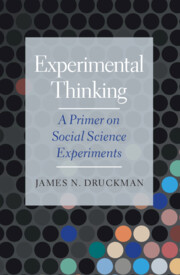Book contents
- Experimental Thinking
- Experimental Thinking
- Copyright page
- Dedication
- Contents
- Figures
- Tables
- Preface
- Acknowledgments
- 1 Why a Primer on Social Science Experiments?
- 2 The Scientific Process and How to Think about Experiments
- 3 Evaluating Experiments
- 4 Innovations in Experimental Designs
- 5 What to Do before, during, and after an Experiment
- 6 Designing “Good” Experiments
- References
- Index
3 - Evaluating Experiments
Realism, Validity, and Samples
Published online by Cambridge University Press: 12 May 2022
- Experimental Thinking
- Experimental Thinking
- Copyright page
- Dedication
- Contents
- Figures
- Tables
- Preface
- Acknowledgments
- 1 Why a Primer on Social Science Experiments?
- 2 The Scientific Process and How to Think about Experiments
- 3 Evaluating Experiments
- 4 Innovations in Experimental Designs
- 5 What to Do before, during, and after an Experiment
- 6 Designing “Good” Experiments
- References
- Index
Summary
Chapter 3 focuses on how to think when evaluating experiments. This includes a discussion of realism, particularly why mundane realism or resemblance to the “real world” receives far too much attention, as well as an overview of how to design experimental treatments. The chapter then turns to validity issues, offering a new way to think about external validity in assessing experiments. This includes a detailed discussion of sampling and why the onus should be more on critics of an experimental sample than on the experimentalist him/herself (i.e., to justify a sample).
Keywords
- Type
- Chapter
- Information
- Experimental ThinkingA Primer on Social Science Experiments, pp. 51 - 84Publisher: Cambridge University PressPrint publication year: 2022

